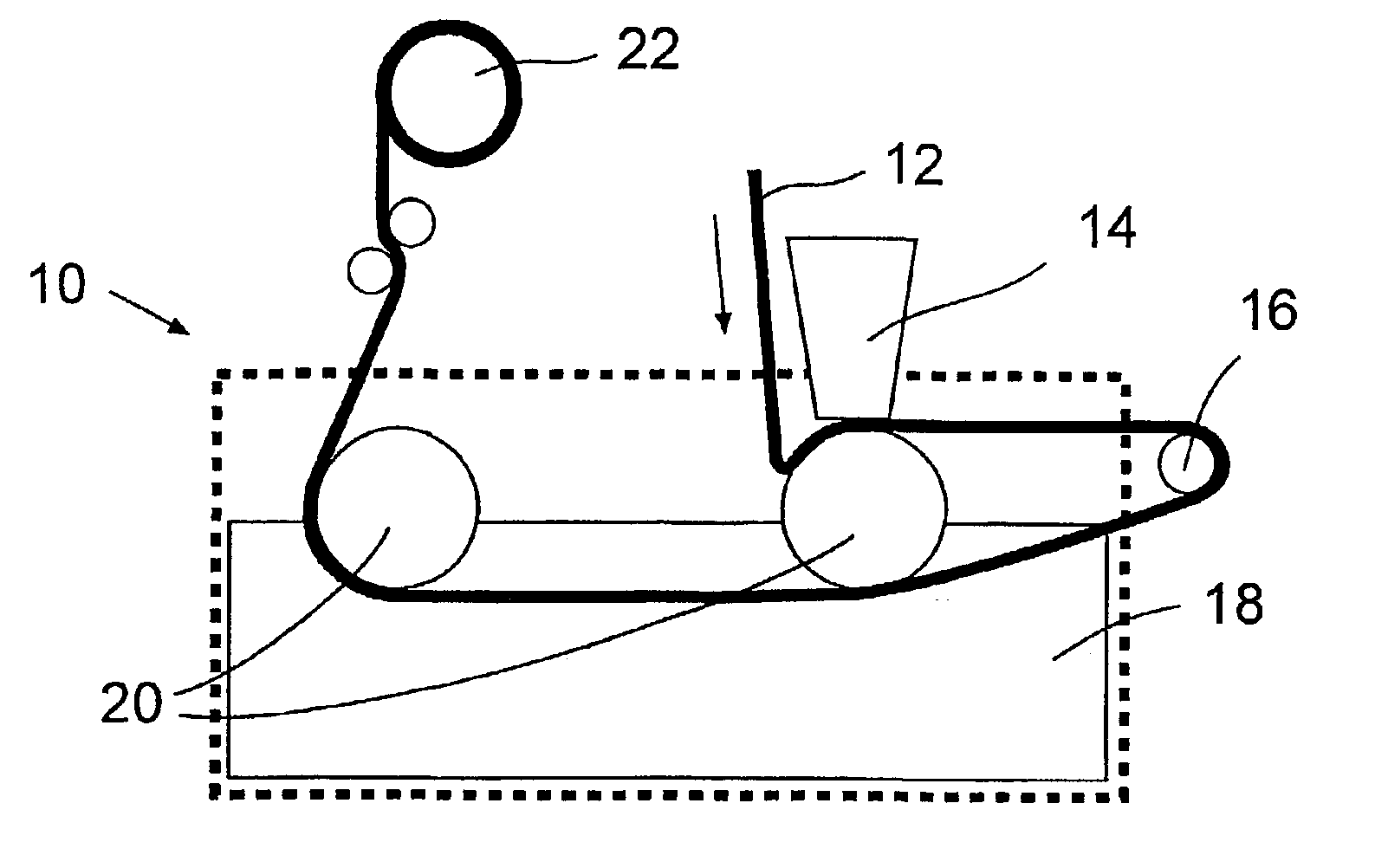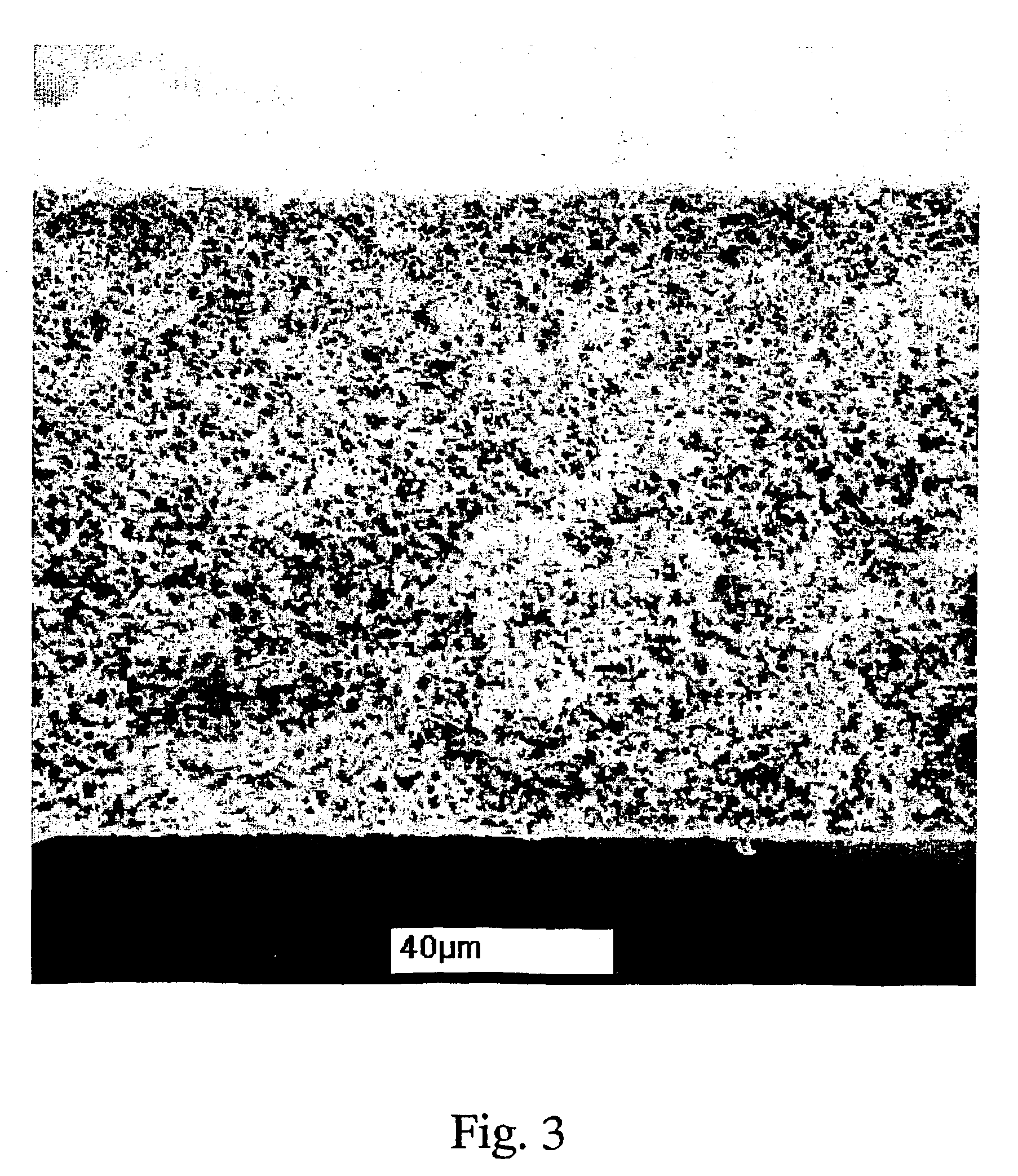Method of manufacturing membranes and the resulting membranes
a technology of microporous membranes and manufacturing methods, which is applied in the direction of membranes, filtration separation, separation processes, etc., can solve the problems of reducing the effective mass of solution heated, reducing process yield, and difficult fine control of the thermal history of large viscous solution, etc., to achieve different profiles and large pore sizes
- Summary
- Abstract
- Description
- Claims
- Application Information
AI Technical Summary
Benefits of technology
Problems solved by technology
Method used
Image
Examples
example i
[0049]The initial experiment showed that by a short exposure of a cast film, before phase separation but after formation, to heat, the bubble point of a membrane can be changed drastically.
[0050]A 20 w % PVDF solution is made with N-methylpyrrolidone. This film is cast on a polyester sheet and subsequently placed on a hot stage for different times. This heat treated film is then immersed into a methanol bath for 2 minutes and washed with water. Finally the membranes are air dried under restraint.
[0051]
TABLE 1TemperatureIPA peak bubble pointTreatment time(Centigrade)(psi)10 sec501230 sec50202 × 2 sec 50100 (no heat treatment)—54-50 psi
[0052]Surprisingly, the bubble point of the membranes was clearly changed in a relatively small time frame, see Table 1.
example ii
[0053]By using the thermal assisted casting process, membranes with improved fluxes can be made if the exposure time is limited. To obtain better reproducible results, a heated rod was installed on a continuous casting machine. The support belt was conveyed over this rod during casting. An air gap between the heating rod and the coagulation bath was placed to allow the film to cool down to reduce flammability issues in this particular case.
[0054]A 20 w % PVDF solution was made in N-methylpyrrolidone at room temperature. A thin film of polymer solution was cast continuously onto a polyester belt. This cast film was exposed for various times to a heated rod at a controlled temperature. Table 2 displays the time and temperatures of the heat exposure. This heat treated film was quenched into methanol at room temperature and extracted in water, then air dried under restraint.
[0055]
TABLE 2Thickness corrected airTemperatureExposure timeflux(Centigrade)(seconds)Bubble Point(scfm / psi * um)45...
example iii
[0058]Asymmetry in PVDF membranes: SEM confirmation
[0059]A PVDF solution was made of 20 w % PVDF In NMP. Membranes were machine cast by exposing a cast film (6 mil gap) to a heated rod for 2 seconds. Two different types of structures were formed using the same lacquer and coagulation procedure: a symmetric, unskinned PVDF membrane with low bubble point (high temperatures) and an asymmetric membrane (at intermediate temperatures). An image of such an asymmetric structure of the present invention is shown in cross section FIG. 3. FIG. 4 shows the top surface of the membrane of FIG. 3 and FIG. 5 shows the bottom surface of the membrane of FIG. 3.
[0060]
TABLE 3Peak Bubble PointTemperature (C.)(psi)43774613
[0061]Unlike what is usually seen with basically symmetric membranes, the bath side of the membrane has a more tight and irregular structure compared to the belt side.
[0062]In all of the examples no macrovoids or filamentous webs were formed, thereby providing a more efficientand effect...
PUM
| Property | Measurement | Unit |
|---|---|---|
| size | aaaaa | aaaaa |
| size | aaaaa | aaaaa |
| pore size | aaaaa | aaaaa |
Abstract
Description
Claims
Application Information
 Login to View More
Login to View More - R&D
- Intellectual Property
- Life Sciences
- Materials
- Tech Scout
- Unparalleled Data Quality
- Higher Quality Content
- 60% Fewer Hallucinations
Browse by: Latest US Patents, China's latest patents, Technical Efficacy Thesaurus, Application Domain, Technology Topic, Popular Technical Reports.
© 2025 PatSnap. All rights reserved.Legal|Privacy policy|Modern Slavery Act Transparency Statement|Sitemap|About US| Contact US: help@patsnap.com



